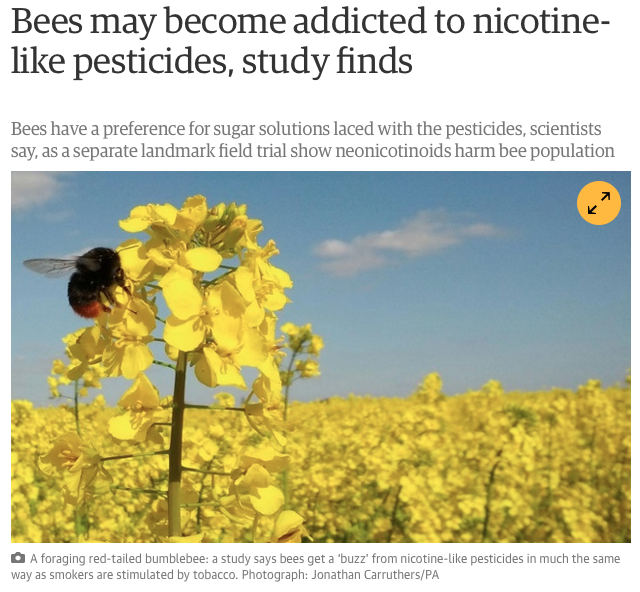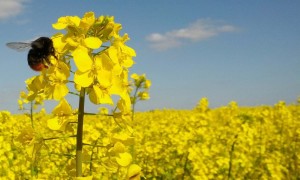
Estudo revela que abelhas podem ficar “dependentes” dos neonicotinoides
Jornal: The Guardian
22 de Abril de 2015
Matéria do jornal inglês The Guardian relata os estudos publicados recentemente na Revista Nature, pelos cientista da Universidade de Newcastle, que demonstraram que as abelhas tem preferência por soluções de açúcar que contém o imidacloprid e o thiamethoxam, possivelmente indicando que as abelhas podem se tornar dependentes a estes produtos químicos, tal como o ser humano ao cigarro.
Na mesma matéria, o jornal traz a repercussão de outro artigo publicado em 22/04 , também na mesma Revista Nature, de mais uma evidência de que o grupo de pesticidas neonicotinóides afetam as colônias de abelhas na natureza, incluindo as Bombus e as abelhas solitárias. Este estudo, produzido por cientistas da Universidade Lund da Suécia, com abelhas silvestres do gênero Bombus, demonstrou que os ninhos das colônias que coabitam campos tratados com neonicotinoides pararam de crescer, e que as abelhas produziam muito menos rainhas onde os pesticidas se faziam presentes.
Para o pesquisador Dr Maj Rundlöf, líder do grupo deste estudo, os impactos sobre as abelhas silvestres foram “dramáticos”: “Acredito que realmente são importantes evidências para que possamos debater como os neonicotinoides utilizados na agricultura influenciam as abelhas”, disse.
Por sua vez, as indústrias agroquímicas questionam as metodologias empregadas e rebatem os resultados publicados.
Leia a matéria completa abaixo, que acirra o debate o sobre os efeitos dos pesticidas sobre os polinizadores na Europa. Em Dezembro de 2015 encerra-se o período de 2 anos em que os pesticidas neonicotinóides foram banidos para uso em algumas culturas na Europa.
Wednesday 22 April 2015 18.00 BST
Bees may become addicted to nicotine-like pesticides, study finds
Bees have a preference for sugar solutions laced with the pesticides, scientists say, as a separate landmark field trial show neonicotinoids harm bee population.

A foraging red-tailed bumblebee: a study says bees get a ‘buzz’ from nicotine-like pesticides in much the same way as smokers are stimulated by tobacco. Photograph: Jonathan Carruthers/PA
Bees may become addicted to nicotine-like pesticides in the same way humans get hooked on cigarettes, according to a new study, which was released as a landmark field trial provided further evidence that such neonicotinoids harm bee populations.
In a study published in the journal Nature, scientists from Newcastle Univeristy showed that bees have a preference for sugar solutions that are laced with the pesticides imidacloprid and thiamethoxam, possibly indicating they can become hooked on the chemicals.
Also published in Nature on Wednesday was a study that has been endorsed as the most conclusive evidence yet that the group of pesticides, neonicotinoids, harm wild bee populations, which include bumblebees and solitary bees.
Scientists from Lund University in Sweden carried out the first successful ‘real world’ experiment on the effect of neonicotinoids on bees and found that wild bee populations halved around fields treated with them. Bumblebee hives stopped growing and produced less queens where the chemical was present. However the study did not find evidence that more robust honeybees, which are used to pollinate many crops, were affected.
Dr Maj Rundlöf, the lead author of the study, said the impacts on wild bees were “dramatic”. “I think it’s really important evidence when discussing how neonicotinoids used in real agricultural landscapes influence bees,” she said.
Dave Goulson, a bee expert at Sussex University, not involved in the research, hailed the findings as hugely significant.
“At this point in time it is no longer credible to argue that agricultural use of neonicotinoids does not harm wild bees.” He said the paper was “a major step forwards in clarifying the neonicotinoid debate … This was the first fully field-realistic, well-replicated trial so far, an impressive piece of work.”
Previous field experiments on neonicotinoids have been shown to be inadequate. The current EU moratorium on the use of a group of neonicotinoids on certain crops has been criticised, particularly by the UK government, on the basis that field evidence of neonicotinoids harming bee populations has been difficult to obtain.
Nick von Westenholz, chief executive of the Crop Protection Association that represents neonicotinoid producers Bayer and Syngenta, said: “The latest studies in Nature must be seen in the context of an ongoing campaign to discredit neonicotinoid pesticides, regardless of what the real evidence shows.”
He said Rundlöf’s results were questionable as the levels of the pesticide found in pollen on the bees was higher than in previous studies, suggesting that Rundlöf had treated the crops herself rather than using industry-standard seeds. Rundlöf said the rapeseed in the study were treated following the manufacturers’ recommendations.
“Bayer CropScience is pleased the Swedish study demonstrates yet again there is no effect of neonicotinoids on honeybee colonies in realistic field conditions, consistent with previous published field studies,” said a spokesman for the agrochemical giant. But it criticised the methodology of Rundlöf’s experiment and said the study offered no proof of increased bee deaths.
Rundlöf said the field trial was not sensitive enough to detect anything less than a 20% drop in colony strength. Honeybee colonies are larger and contain far more worker bees than wild bees, meaning it would take longer for neonicotinoids to impact the hives.
Dr Christopher Connolly, from the Medical Research Institute at Dundee University, said: “Much longer periods would be required to detect deficits in honeybee colonies.” He said the evidence of the effect on bumblebees was a “major advance”.
In the other study published on Wednesday, a team at Newcastle University in England discovered bees cannot detect the presence of neonicotinoids at low levels. In fact for two varieties of pesticide they tended to prefer toxin-laced sucrose.
Scientists suggested the chemicals, which have a similar molecular structure to nicotine, may be affecting the reward centres in bee’s brain in the same way humans are affected by cigarettes.
Professor Geraldine Wright, who led the study, said that the addictive effect was not something they had tested for and was only a hypothesis.
“Like nicotine they are essentially amplifying the rewarding properties of the sucrose solution that they are located in and the bees think its more rewarding so they go back to that food tube to drink more of it,” she said. Previous studies have showed rat’s brain responding to neonicotinoid in this way.
Wright said she was confident the evidence that bees cannot taste neonicotinoids would be replicated in the field. This contradicts previous suggestions, again from the UK government among others, that bees can choose to collect pollen from non-treated plants.
Connolly said: “It will be interesting to see if insects become addicted to neonicotinoids over time as humans become addicted to nicotine. Given that the neonicotinoids are commonly found in our farmed environment at these levels, this may have already occurred.”
The pesticide industry said even if there was a preference, there was no effect on the bees’ health. “What’s important is not whether bees show a slight preference for these crops, but that there is no effect on their health when field-realistic amounts of these pesticides are used,” said von Westenholz.
Goulson said that even before the new studies were published on Wednesday, “there was already a large body of evidence which very strongly suggested that exposure of bees to neonicotinoids at field-realistic doses did them substantial harm.”

Sorry, the comment form is closed at this time.